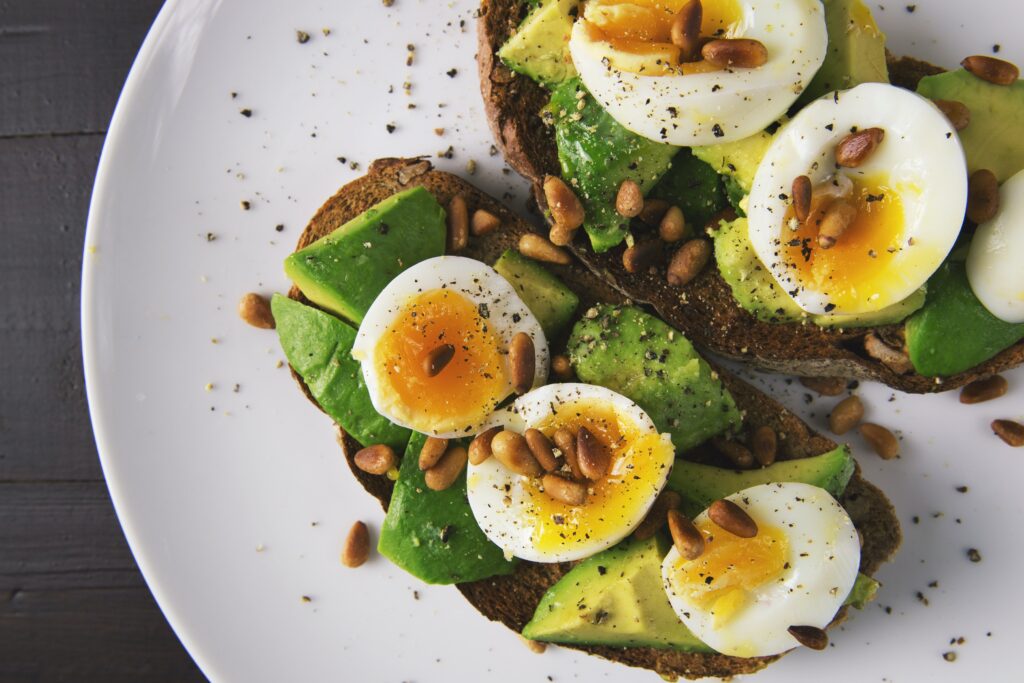
In this article, I will explain what constitutes a balanced breakfast and provide you with ideas and examples of recipes to prepare it. Starting your day with breakfast is important, but it’s equally important to know how to eat a nutritious breakfast.
What Makes an Ideal Breakfast?
An ideal breakfast should avoid the common mistakes often found in breakfast habits, especially among many French people:
– Excessive consumption of sugar, particularly fast sugars.
– Inadequate intake of good fats.
– Insufficient protein.
– Lack of essential nutrients.
It’s time to let go of sugar-filled cereals or muesli that are often mistakenly perceived as healthy choices. You might be thinking, “Great, I have to eliminate everything!” Don’t panic—I’ll first explain what you should eat and then provide you with concrete examples.
A balanced breakfast should consist of foods with a moderate or low glycemic index, along with good fats and proteins from animal or plant sources.
Here are some tips to consider
To transition from your typical breakfast to an ideal one, consider following these recommendations:
- Replace your processed fruit juice with a whole fresh fruit or two. Fruits are rich in fiber and vitamins. Choose any fruit you like! Avoid fruit juices, including homemade ones, as they contain high sugar content and little fiber.
- Opt for tea or coffee without sugar, as hot water increases the feeling of satiety. If you’re accustomed to sweetened beverages, replace white sugar with a small amount of honey or stevia, a natural sweetener.
- Incorporate animal or plant-based proteins, such as eggs prepared as omelets scrambled, or fried.
- Include dried nuts in your breakfast, such as almonds, walnuts, hazelnuts, or Brazil nuts. You can experiment with different varieties as they offer a delightful taste.
- When it comes to bread, make the right choice by selecting wholemeal flour bread instead of white flour bread.
- If you enjoy having a bowl of cereal, opt for unsweetened uncooked flakes such as oats or buckwheat. This way, you can avoid consuming excessive added sugars, which are commonly present in many commercial cereals.
- For those who dislike cow’s milk, replace it with plant-based milk alternatives like almond, rice, hazelnut, or coconut milk. Be cautious while selecting plant milk, as some manufacturers add a significant amount of sugar. Therefore, read the labels carefully.
By now, you understand that your previous breakfast choices were not well-suited to your nutritional needs. Consuming excessive sugar while lacking protein often leads to energy depletion and hunger pangs around 11 am.
What Foods to Include in Your Morning Meal?
Here is a list of foods that you can include to prepare a balanced breakfast:
- Red fruits and berries (blueberries, blackberries, currants, etc.).
- Plain or vegetable yogurt.
- Nuts, almonds, and hazelnuts.
- Oat flakes.
- Wholemeal or rye bread with peanut butter.
- Coffee or green tea without sugar.
- Eggs, bacon, ham, or other protein sources.
- Smoked salmon, sardines, anchovies, or similar fish options.
- Olive oil or coconut oil.
- Chia, flax, sesame, or pumpkin seeds.
- Avocado, spinach, arugula, salad, tomatoes, and other vegetables.
Example 1: Balanced Breakfast
Ingredients:
- Unsweetened flakes (oats or buckwheat).
- Fruit (banana, apple, pear, kiwi, mango, pineapple, red fruits, etc.).
- Unsalted mix of nuts (almonds, walnuts, hazelnuts, etc.).
- Cinnamon (optional).
- Vegetable milk (almond, rice, hazelnut) or fresh cheese.
- White tea or coffee without sugar.
Instructions:
- Cut your fruit into pieces and add a large handful of flakes, a handful of dried nuts, and some raisins.
- Optionally, sprinkle half a teaspoon of cinnamon and add a bit of vegetable milk.
- Estimated preparation time: 3 minutes! Efficient, isn’t it?
Example 2: Balanced Breakfast (Savory Option)
Ingredients:
- 1 avocado.
- 2 slices of wholemeal, cereal, or spelled bread.
- 1 organic egg.
- Grated raw milk cheese.
- Flax seeds.
- Green tea or coffee without sugar.
Instructions:
- Prepare scrambled eggs with cheese, turmeric, and black pepper.
- Toast two large slices of bread.
- Spread avocado on the bread, add the scrambled eggs on top, and finally sprinkle flax seeds.
- This breakfast is ideal for athletes as it contains a significant amount of protein and good fats.
- If you enjoy savory foods, you can find more savory breakfast recipes in my next article.
Example 3: Balanced Breakfast
Ingredients:
2 rice flour and oatmeal pancakes.
Peanut or almond butter.
Blueberries.
Pumpkin seeds.
Maté or rooibos.
Pancake instructions:
- In a bowl, mix 2 organic eggs with brown rice or buckwheat flour, oatmeal, salt, and pepper.
- Heat a pan with coconut oil over medium heat.
- Spread the mixture to form 2 pancakes in the pan.
- Allow 3 to 5 minutes for the pancakes to “set” and brown before flipping them with a spatula.
- Let them brown for another 3 minutes, then serve them on your plate.
- Add almond or peanut butter (plain or salted) with some pumpkin seeds for added crunch.
- Optionally, you can include sliced bananas or blueberries.
Example 4 (for sports enthusiasts): Balanced Breakfast
1 omelet made with 2 organic eggs and cheese.
1 bowl of oatmeal with vegetable milk (soy, almond, or rice).
Red fruits + almonds.
Coffee with honey or agave syrup.
This breakfast is easy to prepare and provides sustained energy for several hours. Adjust the quantities according to your hunger and level of physical activity.
Can You Eat Eggs Every Morning?
Consuming eggs daily is not harmful. Eating up to 3 whole eggs per day does not appear to have negative effects on health or cholesterol levels. In approximately 70% of individuals, eggs have no significant impact on total LDL cholesterol, commonly known as “bad cholesterol.” Even among those who experience a mild increase in LDL cholesterol, the risk of heart disease does not seem to be elevated.
However, it is important to choose organic eggs from free-range hens to ensure their quality.
Breakfasts to Avoid
What do most French people typically have for breakfast? White bread (often the famous baguette) with butter and jam or cereals. Since you haven’t consumed anything throughout the night, you feel thirsty and have a glass of fruit juice. You might also consume milk or yogurt, believing it is crucial for calcium and bone health.
However, this breakfast contains excessively processed foods and fast sugars. As a result, blood sugar levels rise rapidly, leading to quick hunger and a severe lack of energy. Have you noticed that even after consuming a large, hearty breakfast, you often feel hungry in the morning? It’s what we commonly refer to as the infamous 11 am hunger pangs!
Sometimes you might feel less hungry if you skip breakfast. Now you understand why?
Note: It’s important to remember that individual nutritional needs may vary, so it’s always a good idea to consult with a healthcare professional or registered dietitian to determine the best breakfast options for your specific requirements.


